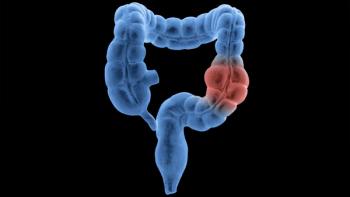
Alectinib Reduces Risk of Recurrence or Death by 76% in Early-Stage, Resected, ALK+ NSCLC
Adjuvant alectinib significantly improved disease-free survival in patients with ALK-positive, early-stage, non–small-cell lung cancer.
Alectinib (Alecensa), an oral ALK inhibitor, significantly improved disease-free survival (DFS) among patients with resected ALK-positive non–small-cell lung cancer (NSCLC), according to data from the phase 3 ALINA trial (NCT0345076).1
The findings, which were presented at the 2023 ESMO conference, showed that the targeted therapy elicited superior outcomes than platinum-based chemotherapy across all prespecified subgroups.
Key Findings
The median follow up was 27.9 months with alectinib and 27.8 months with chemotherapy.
Patients with stage II-IIIA who received alectinib (n = 116) had a 76% reduced risk of disease recurrence or death (HR, 0.24; 95% CI, 0.13-0.45; P < .0001), compared with those who received platinum-based chemotherapy (n = 115). Among these 2 groups, the median DFS was not reached (95% CI, 28.5-not evaluable [NE]) with alectinib vs 44.4 months (95% CI, 27.8-NE) with chemotherapy.
Further, the 2-year DFS rates were 93.8% vs 63.0%, respectively. The 3-year DFS rates were 88.3% vs 53.3%.
In the intention-to-treat population (ITT), which included the entire study population with stage IB-IIIA disease, the median DFS was not reached among patients who received alectinib (n = 130) vs 41.3 months (95% CI, 28.5-NE) among those who received chemotherapy (n = 127). Again, the improvement in DFS yielded a 0.24 hazard ratio (95% CI, 0.13-0.45; P < .0001).
Also in the ITT population, the rates of 2-year DFS were 93.6% vs 63.7% and the 3-year DFS rates were 88.7% vs 54.0%, respectively.
Of note, the rate of grade 3 or 4 adverse events (AEs) was similar between the 2 groups: 30% and 31% of patients receiving targeted or chemotherapy, respectively, reported high-grade AEs. No grade 5 events were reported in either cohort.
“Treatment with adjuvant alectinib resulted in a statistically significant and clinically meaningful improvement in DFS compared with chemotherapy,” Ben Solomon, MBBS, PhD, FRACP, a Medical Oncologist at the Peter MacCallum Cancer Centre in Australia, said in a presentation of the data.
“The DFS benefit was seen consistently across subgroups and an improvement in CNS-DFS was observed,” Solomon said.
In terms of overall survival (OS), data were still immature at data cutoff, with only 6 events reported.
Significance
Among patients with NSCLC, approximately 4 to 5% will harbor an ALK rearrangement. These patients tend to be 55 years or younger, to not have a history of smoking, and to be at a higher risk of brain metastases—nearly half of patients with ALK alterations develop brain metastases.
Approximately 30% to 40% of patients with NSCLC will receive a diagnosis of resectable disease. Unfortunately, nearly half of patients with early-stage disease will experience disease recurrence after surgery, highlighting the importance of effective adjuvant options in this space.
The standard treatment approach following surgery is currently platinum-based chemotherapy for patients with stage IIB-IIIA, ALK-positive disease, however this modality is associated with modest improvements in survival outcomes. Similarly, immunotherapy approaches have not been fruitful for patients with resected, ALK-positive disease.
Alectinib already plays a role for certain patients with ALK-positive NSCLC. For patients with advanced disease who have not yet undergone resection, alectinib is the preferred front-line regimen. Three distinct phase 3 trials have demonstrated significant progression-free survival benefits and intracranial control with alectinib vs crizotinib in this setting. It is also associated with a high rate of intracranial activity. As of August 2023, it is estimated that more than 92,000 patients with ALK-positive disease have been treated with the oral TKI.
The current findings are the first to compare this agent against platinum-based chemotherapy in a population of ALK-positive patients in the adjuvant setting.
Methodology
ALINA enrolled patients with completely resected stage IB-IIIA, ALK-positive NSCLC. To be eligible, they needed an ECOG PS of 0 to 1, adequate end-organ function, and to be naïve to prior systemic therapies. They also needed to be eligible to receive platinum-based chemotherapy. Patients were stratified by stage (II vs IIIA) as well as by race (Asian vs non-Asian).
The 257 participants were randomly assigned 1:1 to undergo treatment with either alectinib or platinum-based chemotherapy. Patients in the alectinib cohort received 600 mg twice daily for 2 years and those receiving chemotherapy received their treatment every 3 weeks for 4 cycles. Both arms continued treatment until recurrence occurred — at which point their investigator chose their sequential treatment and survival follow-up commenced.
Baseline characteristics were balanced between the 2 arms, with a slightly higher proportion of females in the alectinib arm (58% vs 46%). Most patients were never smokers who had undergone a lobectomy and had non-squamous disease. Of note, 53% of patients in the alectinib arm and 55% of patients in the chemotherapy arm had stage IIIA disease. Additionally, 49% and 52% of patients, respectively, had N2 nodal status at baseline.
The primary end points were DFS per investigator assessment. DFS was tested hierarchically. First, it was assessed among those with stage II-IIIA disease. Then, it was assessed in the intention-to-treat population (stage IB-IIIA patients).
Secondary end points included central nervous system (CNS) DFS, OS, and safety.
These findings are from a pre-planned interim analysis, following 67% of events in the stage II-IIA subpopulation. The clinical cut-off date was June 26, 2023.
Secondary Outcomes
“In terms of the subgroup analysis, benefit in favor of alectinib was seen across all the pre-defined subgroups evaluated, including stage and nodal status,” Solomon emphasized in the presentation.
When looking at DFS by stage, the 2-year results continued to favor alectinib. For those with stage IB disease (n = 26), stage II (n = 92), and stage IIIA (n = 139) disease, respectively, the rates of DFS after 2 years were 92.3%, 95.6%, and 92.7% with alectinib vs 71.6%, 66.3%, and 60.7%, respectively.
Therefore, the reduced risk of death or recurrence was 79% with stage IB (HR, 0.21; 95% CI, 0.02-1.84), 76% with stage II (HR, 0.24; 95% CI, 0.09-0.65) and 75% with IIIA disease (HR, 0.25; 95% CI, 0.12-0.53), respectively.
In addition, 4 patients receiving alectinib vs 14 patients receiving chemotherapy in the ITT population experienced brain recurrence (HR, 0.22; 95% CI, 0.08-0.58). The rate of CNS DFS at 2 years was 98.4% vs 85.8%, respectively. At 3 years, the rates were 95.5% vs 79.7%.
“CNS [DFS] was an important exploratory end point of the study,” Solomon noted. “CNS imaging was mandated at baseline and serially with disease assessments with MRI, if feasible.”
Regarding the agent’s safety summary, the median duration of treatment was 23.9 months with alectinib and 2.1 months with chemotherapy, leading to a longer safety follow-up time with the targeted treatment. The rate of any-grade AEs was 98% vs 93%, respectively. Of note, a higher percentage of patients receiving alectinib needed to dose reduce because of an AE (26% vs 10%) or interrupt treatment because of an AE (27% vs 18%), although fewer needed to discontinue treatment overall (5% vs 13%).
The most common AEs reported with alectinib were increased in blood creatinine phosphokinase, constipation, and increases in aspartate aminotransferase and alanine aminotransferase increase, as well as an increased in blood bilirubin. In the chemotherapy arm, the most common AEs were nausea, constipation, anemia, and decreased appetite.
There are currently 3 other clinical trials studying alectinib in stage I-III NSCLC, including the phase 2 NAUTIKA1 trial (NCT04302025), the phase 2 ALNEO trial (NCT05015010), and the phase 3 HORIZON-01 trial (International NCT05170204). The manufacturers have announced that they intend to file these data with the FDA and the European Medicines Agency following the presentation of the data.2
“Adjuvant alectinib was tolerable and in line with the known safety profile of alectinib,” Solomon concluded. “Adjuvant alectinib represents an important new treatment strategy for patients with resected, stage IB-IIIA, ALK-positive, NSCLC.”
References
- Solomon BJ, Ahn, JS, Dziadziuszko R, et al. Efficacy and safety of adjuvant alectinib versus chemotherapy in patients with early-stage ALK+ non-small cell lung cancer (NSCLC). Ann Oncol. 2023;34(suppl 2):LBA2
- Roche’s Alecensa reduces the risk of disease recurrence or death by an unprecedented 76% in people with ALK-positive early-stage non-small cell lung cancer. News release. Roche. October 21, 2023. Accessed October 21, 2023.
https://www.fiercepharma.com/pharma/roches-alecensa-staves-lung-cancer-recurrence-en-route-postsurgery-expansion#:~:text=Alecensa%20reduced%20the%20risk%20of,for%20Medical%20Oncology%202023%20congress
Newsletter
Knowledge is power. Don’t miss the most recent breakthroughs in cancer care.

























































































